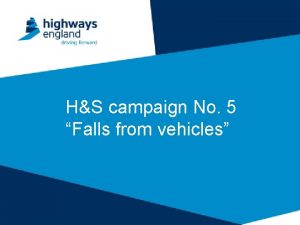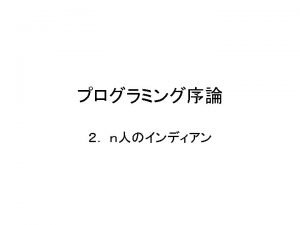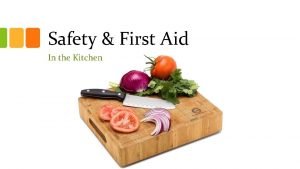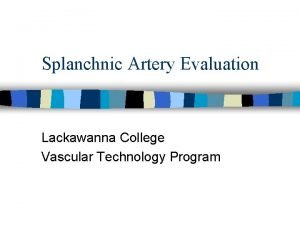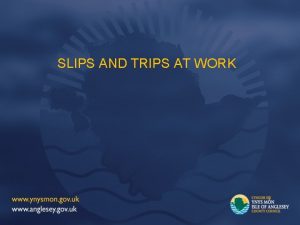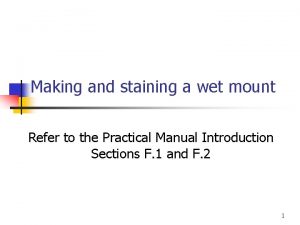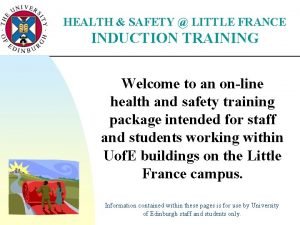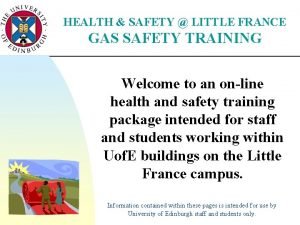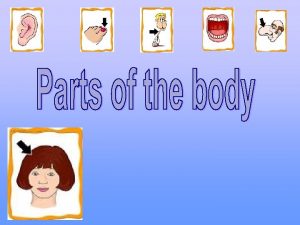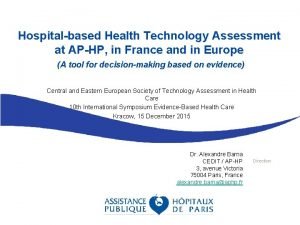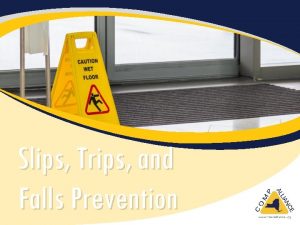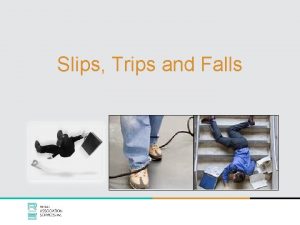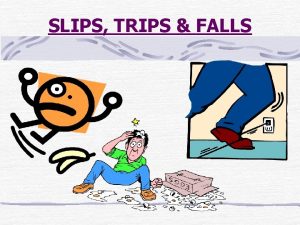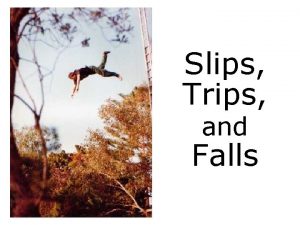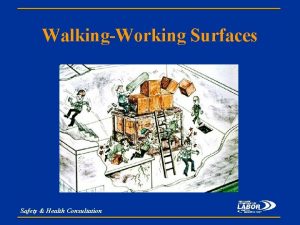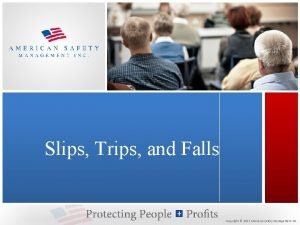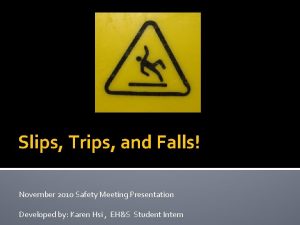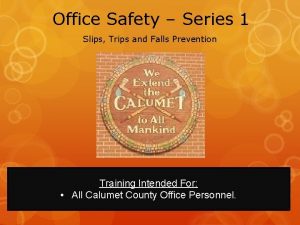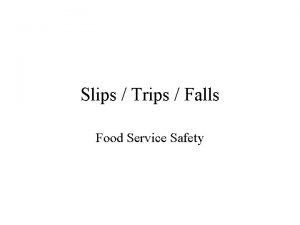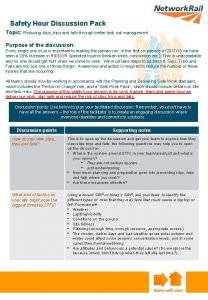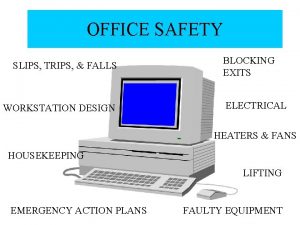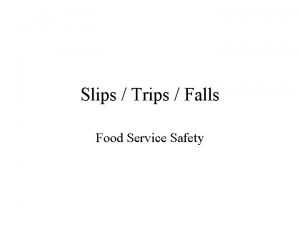HEALTH SAFETY LITTLE FRANCE SLIPS AND TRIPS Welcome


















- Slides: 18

HEALTH & SAFETY @ LITTLE FRANCE SLIPS AND TRIPS Welcome to an on-line health and safety training package intended for staff and students working within Uof. E buildings on the Little France/Bioquarter campus Information contained within these pages is intended for use by University of Edinburgh staff and students only.

HEALTH & SAFETY @ LITTLE FRANCE SLIPS AND TRIPS This on-line training package is intended for workers based within University buildings on the Little France campus, but is not a substitute for practical training which may be organised by senior laboratory managers. Last updated: November 2013

HEALTH & SAFETY @ LITTLE FRANCE SLIPS AND TRIPS Please take time to view the following material, and direct any urgent questions to your H&S Advisor, Supervisor/Manager, or the Little France Buildings H&S Manager (the contact details for whom are shown on the last page of this presentation). Thank you

HEALTH & SAFETY @ LITTLE FRANCE SLIPS AND TRIPS HSE reports that slips and trips are the most common of workplace hazards, and make up over a third of all major injuries in the workplace. Something like 10, 000 workers per annum, in the UK alone, suffer serious injuries because of a slip or trip.

HEALTH & SAFETY @ LITTLE FRANCE SLIPS AND TRIPS Approximately 95% of major slips result in broken bones. One or two fatalities per year arise from slip/trip events. Slip/trip injuries cost the UK’s health sector more than £ 100 million and UK employers more than £ 500 million per annum in lost production and other costs.

HEALTH & SAFETY @ LITTLE FRANCE SLIPS AND TRIPS Nevertheless: • Many people apparently don’t take these risks seriously enough. • There is generally little understanding of the causes of slipping. • Some seem to think that slips and trips are simply inevitable. • And there is often a very poor application of risk assessment and management controls.

HEALTH & SAFETY @ LITTLE FRANCE SLIPS AND TRIPS Most slips occur in wet conditions, and most trips are due to poor housekeeping. The solutions are often simple and cost effective, and a suitable assessment should be made of the risks.

HEALTH & SAFETY @ LITTLE FRANCE SLIPS AND TRIPS Risk assessment will help identify necessary controls, and should include consideration of: • Design of the workplace and work activities • Appropriate flooring and floor coverings • Suitable footwear for workers, etc • Prevention of contamination • Prompt and effective management of spillages • Maintenance of plant and the work environment • Good housekeeping and cleaning regimes • Effective training and supervision

HEALTH & SAFETY @ LITTLE FRANCE SLIPS AND TRIPS Flooring: • Floors must be well maintained to ensure that there are no trip hazards e. g. holes, uneven surfaces, curled-up carpet edges, etc. • Special considerations apply to slopes, ramps, stairs, etc; • When a floor becomes unavoidably wet or slippery, appropriate warning signage should be displayed; and … • All spillages must be promptly, effectively and safely managed.

HEALTH & SAFETY @ LITTLE FRANCE SLIPS AND TRIPS Footwear: • Flat shoes with a sensible heel, and with soles and heels made of a material that provides some grip, but which are not opentoed, are sensible for work in most laboratory environments. • For some work (e. g. moving and handling compressed gas cylinders), consideration should be given to a possible need for toecap reinforcement. • But remember that footwear can perform differently in different situations.

HEALTH & SAFETY @ LITTLE FRANCE SLIPS AND TRIPS Workplace: • Avoid introducing obstacles along walkways, particularly when these are also designated as escape routes. • Plan work to minimise the potential for spillages onto the floor. • Consider also the trip hazard potential associated with railing cable flexes, hose runs etc, and run these under anti-trip guard strips.

HEALTH & SAFETY @ LITTLE FRANCE SLIPS AND TRIPS Contamination: • Ensure easy access to spill management kits for rapid clean-up. • Consider that contamination may also arise from open windows, wet footwear, dripping coats etc. • In any event, always use safe technique*. * http: //docstore. mvm. ed. ac. uk/Health. And. Safety/presentations/Spill. Management. ppt

HEALTH & SAFETY @ LITTLE FRANCE SLIPS AND TRIPS Cleaning: • This is not just the job of cleaners; Everyone has a role, especially if they’ve created a potential for slip/trip injuries. • But the process of cleaning too can create a potential for slip/trip (wet floors while mopping, and trailing power cables supplying floor buffers, etc). • A display of warning signage is likely to be appropriate. • Special arrangements may be appropriate in some areas.

HEALTH & SAFETY @ LITTLE FRANCE SLIPS AND TRIPS Top tips for cleaning: • Use the right amount of the right cleaning product in the right places for the right amount of time. • Cleaning equipment will only be effective if it is well maintained. • Even a well-wrung mop will leave a film of water sufficient enough to create a slip risk hazard on a smooth floor surface. • Spot-clean where possible. • Display appropriate warning signage.

HEALTH & SAFETY @ LITTLE FRANCE SLIPS AND TRIPS Human factors: • People very often will just notice that cleaning is going on, and may even walk around signage without seeming to see it. • Cleaners and others should not be reluctant to call out to the seemingly oblivious, to warn them of potential danger. • By the same token, cleaners will be generally receptive to a request to avoid cleaning in a specific area until it would be less problematical for workers.

HEALTH & SAFETY @ LITTLE FRANCE SLIPS AND TRIPS The STEP tool: STEP is an e-Learning package developed by the Health & Safety Executive, providing slips and trips guidance through a programme of interactive learning. It may be accessed at http: //www. hse. gov. uk/slips/step/start. htm

HEALTH & SAFETY @ LITTLE FRANCE SLIPS AND TRIPS Lindsay Murray Health & Safety Manager, The University of Edinburgh, College of Medicine & Veterinary Medicine (Little France/Bioquarter Campus) Room SU 225, Chancellor’s Building Ext: 26390 lgm@staffmail. ed. ac. uk

HEALTH & SAFETY @ LITTLE FRANCE SLIPS AND TRIPS You have now completed this on-line training package, which aims to help prevent slip and trip injuries in and around University buildings on the Little France campus. Please also attend any practical training that may be organised by your supervisor or manager. Thank you
 Slips trips and falls presentation
Slips trips and falls presentation Hse slips trips and falls video
Hse slips trips and falls video Ten little indian boys poem
Ten little indian boys poem 1 little 2 little 3 little indian
1 little 2 little 3 little indian First aid for falls in the kitchen
First aid for falls in the kitchen Sternal and costal slips of diaphragm
Sternal and costal slips of diaphragm Detention slips
Detention slips Tripsatwork
Tripsatwork Cover slips drawing
Cover slips drawing Freudian slip meaning
Freudian slip meaning Freudian slips
Freudian slips Freudian slips
Freudian slips Qmri little france
Qmri little france Qmri little france
Qmri little france Intrazonal vs interzonal
Intrazonal vs interzonal Wise men three clever are we
Wise men three clever are we Quantifier for fresh air
Quantifier for fresh air Two little hands go clap clap
Two little hands go clap clap Hospital based health technology assessment
Hospital based health technology assessment

